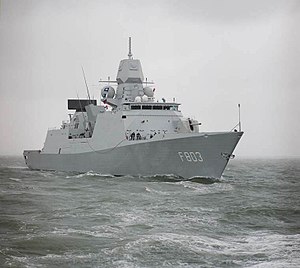HNLMS Tromp (F803)
 HNLMS Tromp at sea (Source: Royal Netherlands Navy)
| |
| History | |
|---|---|
| Name | Tromp |
| Namesake | Maarten Tromp and Cornelis Tromp |
| Laid down | 3 September 1999 |
| Launched | 7 April 2001 |
| Commissioned | 14 March 2003 |
| Identification |
|
| Honours and awards | KNMI Medal |
| Badge |  |
| General characteristics | |
| Class and type | Template:Sclass- |
| Displacement | 6,050 tonnes (full load) |
| Length | 144.24 metres (473.2 ft) |
| Beam | 18.80 metres (61.7 ft) |
| Draft | 5.18 metres (17.0 ft) |
| Propulsion | Template:De Zeven Provinciën propulsion |
| Speed | 30 knots (56 km/h; 35 mph) |
| Complement | 174 (202 incl. command staff) |
| Sensors and processing systems | Template:De Zeven Provinciën sensors |
| Armament | Template:De Zeven Provinciën armament |
| Aircraft carried | 1 x NH-90 helicopter |
HNLMS Tromp (F803) (Dutch: "Zr. Ms. Tromp") is the second Template:Sclass- of the Royal Netherlands Navy. The ship was laid down in 1999, launched in 2001, and commissioned in 2003. The frigate is named after Dutch naval heroes Maarten Tromp (1598–1653) and Cornelis Tromp (1629–1691).[1]
As of 18 June 2010, Commander René Tas is HNLMS Tromp's commanding officer.[2]
Service history
Theatre Ballistic Missile Tracking Exercises, 2006
In November 2006, HNLMS Tromp participated in a live Theatre Ballistic Missile (TBM) Tracking Exercise (TRACKEX). The event took place on the Pacific Missile Range Facility off Hawaii. For the TRACKEX, Tromp was equipped with the experimental Extended Long Range (ELR) modification to its Thales Nederland SMART-L radar. During the exercise, a ballistic missile surrogate was launched from Kauai Island and was successfully tracked by HNLMS Tromp using its ELR-modified SMART-L radar. Another successful TRACKEX was held in December 2006.[3]
Deployment to the Indian Ocean, 2010
Tromp deployed to the Indian Ocean off the coast of Africa as part of Operation Atalanta, which is composed of European Union naval units. The operation is tasked with suppression of piracy in the region.[4]
On 14 March 2010, Tromp responded to a distress call from the transport ship MV Lubeck, which was under attack from two pirate skiffs. Tromp launched her helicopter, which forced the whaler mother ship to stop. Tromp then sent a boarding party to secure the vessel. The following day, Tromp tracked down the two skiffs about 100 km (62 mi) from the whaler and stopped them. Crew from Tromp sank the mother ship,[5] and confiscated satellite phones, AK-47s, a rocket launcher, and boarding equipment.[4]
Three days later, on 17 March 2010, Tromp was involved in an incident with suspected pirates off the coast of eastern Africa. Two small boats approached the frigate at high speed. After realizing Tromp was a warship, the pirates fled. However, Tromp pursued and captured the two boats, along with a mother ship. The frigate destroyed the two boats and released the pirates to the mother ship, after it had been cleared of weapons.[6]
On 5 April 2010, Tromp rescued the container ship MV Taipan by rappelling 6 Marines from its Lynx helicopter (under covering fire from the helicopter and Tromp) to the deck of Taipan, resulting in the capture of 10 pirates. The 13 crew (2 German, 3 Russian, 8 Sri Lankan) were unharmed having taken refuge in a secure location after stopping the ship's engines.[7][8][9]
State Visit Norway, 2010
On 1 June 2010, Queen Beatrix visited Norway aboard Tromp for a 3-day state visit.[10]
2011 Libyan civil war
On her return to her homeport in February 2011 through the Mediterranean, the ship was deployed to the Gulf of Sidra to potentially assist in the safe return of Dutch nationals during the 2011 Libyan civil war. While performing an evacuation mission near the town of Sirte, a Lynx helicopter and its three-man crew were captured by members of the Libyan Army. The Dutch engineer and Swedish woman they were trying to rescue were allowed to leave Libya; negotiations yielded the crew's release.[11]
Gallery
-
HNLMS Tromp in 2006, arriving at Naval Station Pearl Harbor, Pearl Harbor, Oʻahu, Hawaiʻi, United States -
Picture of the side of HNLMS Tromp in 2009, departing Naval Station Norfolk, Norfolk, Virginia, United States.
See also
References
- ^ "Naam & embleem" (in Dutch). Archived from the original on 2011-07-19. Retrieved 2011-03-11.
- ^ "Commando-overdracht Hr. Ms. Tromp" (in Dutch). Archived from the original on 2012-03-18. Retrieved 2011-03-18.
- ^ Jane's Defence Weekly, 5 January 2011, "Aiming high"
- ^ a b "Pirates apprehended by Dutch navy". Expatica.com. March 16, 2010. Retrieved 18 March 2010.
- ^ "EU NAVFOR Destroys 2 more Pirate Action Groups (PAG)". Defense Professionals. March 17, 2010. Archived from the original on 9 July 2011. Retrieved 18 March 2010.
- ^ Jason Straziuso (18 March 2010). "Somali Pirates Try to Hijack Dutch Warship, Then Flee". Associated Press. Retrieved 18 March 2010.[permanent dead link]
- ^ "Dutch sidestep EU red tape to rescue German ship". AP. 5 April 2010.
- ^ "Dutch Navy frees hijacked containership". Marinelog. 5 April 2010. Archived from the original on 8 April 2010. Retrieved 14 April 2010.
- ^ Netherlands Ministry of Defence (April 29, 2010). "Dutch marines storm cargo ship seized by Somali pirates". Youtube.com. Retrieved April 29, 2010.
- ^ Staatsbezoek aan Noorwegen Archived 2010-06-05 at the Wayback Machine - website of the Dutch Royal House (in Dutch)
- ^ "Three Dutch marines captured during rescue in Libya". BBC News. 3 March 2011. Retrieved 3 March 2011.
External links
 Media related to F803 Zr.Ms. Tromp (ship, 2003) at Wikimedia Commons
Media related to F803 Zr.Ms. Tromp (ship, 2003) at Wikimedia Commons- (in Dutch) Hr. Ms. Tromp, official website


